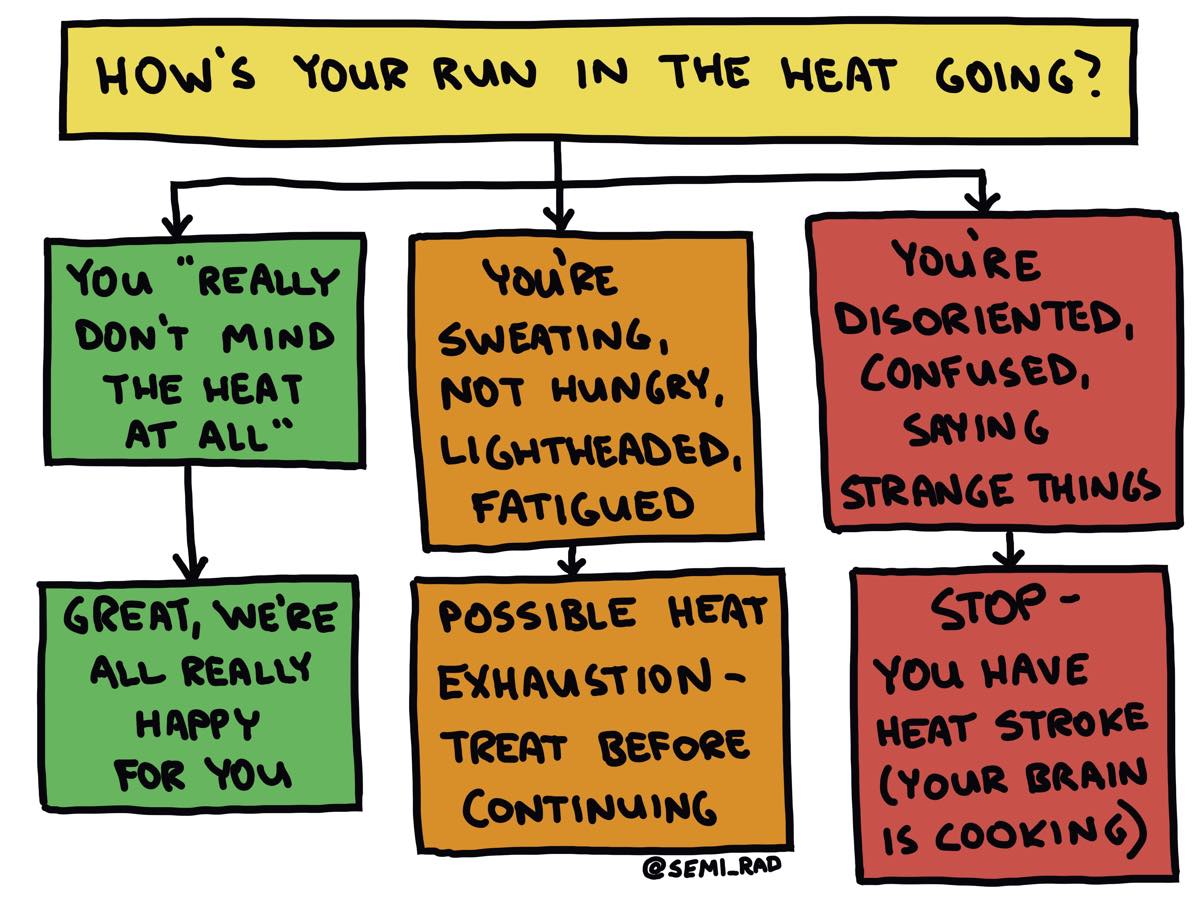You’ve decided to volunteer at the Muleshoe Bend 60k outside Austin, Texas this July. Everybody says you can learn a lot about how to race well by helping runners at an aid station. And you’ve got your first ultramarathon coming up. You want to know what works and, more importantly, what doesn’t. And, of course, you want to build up trail karma.
Muleshoe Bend starts at 7 p.m. because it’s a bit less hot in the evening than it is during the day in South Texas. A bit. Really it’s just less sunny. It’s still 92 degrees Fahrenheit when you get to the aid station. And, of course, it’s humid. (If you haven’t run in South Texas in July, you can simulate the experience by standing in a hot shower in your running clothes and a wool hat. Then wrap yourself in a wool blanket and run uphill.
You fill runners’ water bottles with Tailwind and ice, and you scoop ice into ice scarves, running hats, hydration packs, arm sleeves, and sports bras. You make mental notes to sew yourself an ice scarf for your race and to make sure to bend over when people dump water on your head, so the water doesn’t run into your shoes. Good times!

Image: Brendan Leonard/Semi-Rad
Scenario 1
Then Rich walks into the aid station. He’s a well-known runner and beloved, and all the volunteers yell out his name when he arrives.
“Rich!!!”
He doesn’t smile. He’s drenched in sweat and his clothes are plastered to his body like all the other runners. But he’s also very pale. In fact, he looks sick. He walks over to a camp chair, sits down hard, and puts his head in his hands.
“I don’t feel so good. I’m so hot. I don’t know if I can keep going. I’m really lightheaded. I can’t eat. And I can’t keep my heart rate down. But I can’t drop! I won’t drop!”
Questions
Try to answer each question before reading further.
- What is wrong with Rich?
- What three actions should you take next?
- Should Rich drop from the race?
Answers
- Rich’s symptoms could be caused by a whole slew of things. You’re not a doctor. But when someone’s running in 92-degree-Fahrenheit weather, dehydration, heat stroke, and heat exhaustion are solid guesses. Rule out each one before doing anything else.
Rule out dehydration: Ask Rich if he is thirsty. If he’s not thirsty, dehydration, or low fluid volume, isn’t making him feel so sick. Rich says he’s not thirsty.
Rule out heat stroke: Rich isn’t disoriented. He’s speaking in full sentences and he answered your question about thirst. He walked into the aid station slowly, but without trouble. So you can rule out heat stroke. Your brain is literally being cooked at 104 degrees Fahrenheit or higher with heat stroke, so Rich would be confused, disoriented, or have a decreased level of consciousness. His ability to run or walk would likely be uncoordinated. Heat stroke is a life-threatening emergency. Take a look at this video of a Calum Hawkins at the 2018 Gold Coast Marathon to see an example of a runner with heat stroke.
That leaves us with heat exhaustion. Heat exhaustion is simply an “inability to cope with heat stress.” It’s a big umbrella term that covers a range of symptoms. That wiped-out feeling you have after a long day in the sun that fills you with apathy for everything except lying on the couch is heat exhaustion. Heat exhaustion can also look like Rich. Unlike heat stroke, heat exhaustion may feel bad but it’s not a medical emergency. And, really, the only way to rule out heat exhaustion is to treat for it.
- Decrease the heat.
Put Rich in the shade.
If you have ice, put it in bags, and place those bags around his neck, on his torso, and in his lap. If you don’t have ice, douse Rich in water and fan him.
Don’t let Rich generate heat.
Ask him if he’d be more comfortable lying down. Otherwise, keep him seated and resting.
Have him drink some soda with ice when his stomach feels better or give him a popsicle. Cold drinks and food won’t cool him down, but they’ll give him a big mental boost. (Can I get a witness!?!) And it’s not uncommon for heat-exhausted runners to be low on calories because of their nausea. So soda or popsicles can kill two birds with one stone.
- If Rich feels better after you cool him off and give him some calories, he’s not lightheaded, and you think he’s capable of keeping himself cooled the rest of the race, tell him to get out of your chair and get going!
Otherwise, recommend he call it a day and get him to the start/finish. And tell him to take a look at Corinne Malcolm’s heat-acclimatization article for future hot-weather running.
The scenario continues: You treat Rich, and he improves. He thanks you for saving his race and heads off into the night.
You make some peanut butter and jelly sandwiches, test the M&Ms, and laugh a lot with the other volunteers. Volunteering is great.
Scenario 2
Then a young guy in a “I love Newfoundland” t-shirt stumbles in.
“Woah there! Doing okay?” you ask.
He stares at you blankly and drops his handheld. He wobbles, and then sits down on the ground. He looks up at you confused. “Who? Can’t Tuesday.”
Questions
- What’s wrong with this Newfoundlander?
- What three actions should you take next?
- Can he keep running?
Answers
- Any runner who is disoriented or has decreased level of consciousness in a hot environment should be treated for heat stroke. Assume he’s disoriented because his brain is cooking at 104 degrees Fahrenheit or higher.
- Cool him off fast!
Make sure he’s in the shade.
If you have ice, cover his torso in it. If you have enough, cover him entirely. If there’s a stream or lake, submerge his body in the water. (Protect his airway. He already has heat stroke. Don’t drown him too.)
If you don’t have ice, douse him in water and fan him.
Ask for an ambulance!
Heat stroke is a life-threatening emergency. It is not simply overheating. The body will continue to generate heat even after it’s cooled. This person needs to get to a hospital as fast as possible. Follow the race’s emergency-action plan. (Always ask what that is when you volunteer.)
- Absolutely not. Anyone with a decreased level of consciousness should be taken to a hospital. Fast.
Remember, it’s heat stroke if a runner’s mental status is affected. Treat for heat exhaustion otherwise. And if your common sense is wrong and these folks are sick for some other reason, you can’t hurt them by cooling them off.
You’ll definitely deal with heat-exhausted runners when you volunteer at hot races. You’re unlikely to deal with heat stroke because the body does a great job at protecting the brain and keeping you from cooking it.
Prevention
Share how you prevent heat exhaustion at your races and in training.
[Author’s Note: Learn more about managing blisters and other wilderness first-aid skills with a two-day NOLS course. Thank you to Tod Schimelpfenig, NOLS Wilderness Medicine’s Curriculum Director and author of NOLS Wilderness Medicine, for his guidance and oversight of this series. Thanks also to graphic artist Brendan Leonard, the trail and ultrarunner of Semi-Rad fame, for his graphics collaboration in this article series. ]
